| 1 | A shy Spanish soil dweller |
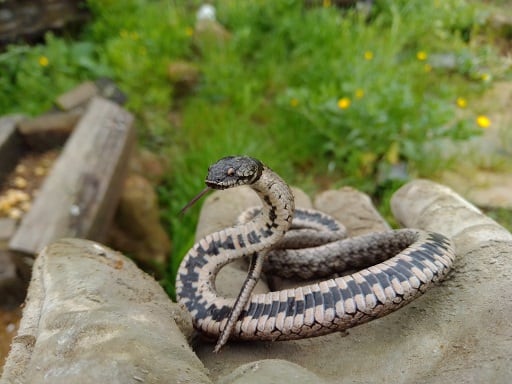
Meeting snakes isn’t hard in Spain, as you only have to spend around 30 minutes in the countryside to be chased by gangs of hungry ladder snakes and Montpellier snakes. But there’s one species which is difficult to find, despite being fairly widespread – the false smooth snake (Macroprotodon brevis).
This species inhabits the lower half of Spain and virtually all of Portugal, as well as North Africa. It’s mildly venomous, but virtually no threat to humans. Rather than greeting tourists in open daylight, the false smooth snake is a species which requires serious, dedicated reptile knowledge to track down. Farmers might stumble across it, and maybe a lucky villager, but an inexperienced tourist roaming the countryside at random has almost no chance.
The reason is that false smooth snakes are a heavily underground-dwelling (fossorial) snake. They’re fully nocturnal, and during daylight they’re almost always underground. It’s a snake which barely moves from its mammal burrow, subterranean rock chamber, or secret grove nestled in a bunch of low-lying thickets.
False smooth snakes nearly always stick to moister areas, with soft soils that they’re able to dig in. Hard, dusty soils are the absolute anathema of this snake. However, as long as there’s sufficient moisture, false smooth snakes have decently flexible habitats. They can be found in soft grassland not far from rivers, damp forest clearings, and the lush outskirts of pine and holm forests. They can also be found in scrublands, and near crumbling ruins with an abundance of old stone.
| 2 | Bites are a mere pinprink |
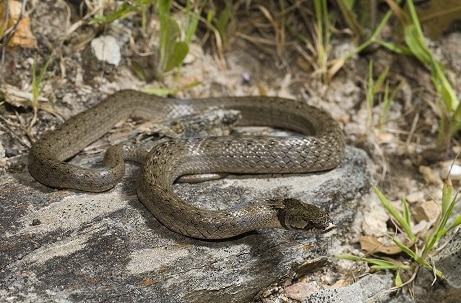
False smooth snakes are far shorter than the 2 meter Montpellier snake. Their average is 40-60cm, and this is identical in Spain and North Africa. False smooth snakes vary from olive to grey, or even gold-looking depending on the light.
Their scales are in a honeycomb pattern, each bordered by tiny white or black lines which alternate evenly. False smooth snakes have a fairly short tail, making up just 14.9% of their body (versus a third for the Chilean-long tailed snake). They have a head which barely thickens from the neck, and like most digging snakes, their head is smooth and pointed.
False smooth snakes are easily recognised because of a signature marking: an unbroken black neck collar, which stretches all the way around their body. This collar is divided very clearly from the rest of its body; it starts suddenly, rather than tapering in. They also have a black marking below their eye, which then travels backwards on their head and sometimes joins the black collar.
| 3 | Orange-tinted eyes |
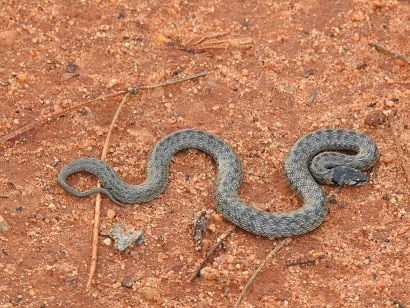
The false smooth snake isn’t a species with wild and wacky colour morphs, but there are two populations with completely black heads. These are found in Cadiz, southern Spain, and the Rif mountains of Morocco. The blackness (which is pitch black) begins where the black collar normally starts.
There’s not much chance of getting close enough to stare a false smooth snake in the face, but if you do, then their eyes are very small, with a faintly orange iris. Their pupils are normally round, but in bright light they morph to become more vertical. The reason why false smooth snakes were once mistaken for real smooth snakes (as you may have guessed) is their smooth and very shiny scales. In reality, the two families are separated by tens of millions years.
False smooth snakes also have a consistent pattern of black spots running down their spine. Unlike the collar though, this black is much weaker and blurs into the surrounding olive scales a lot more.
| 4 | Stays underground by day |
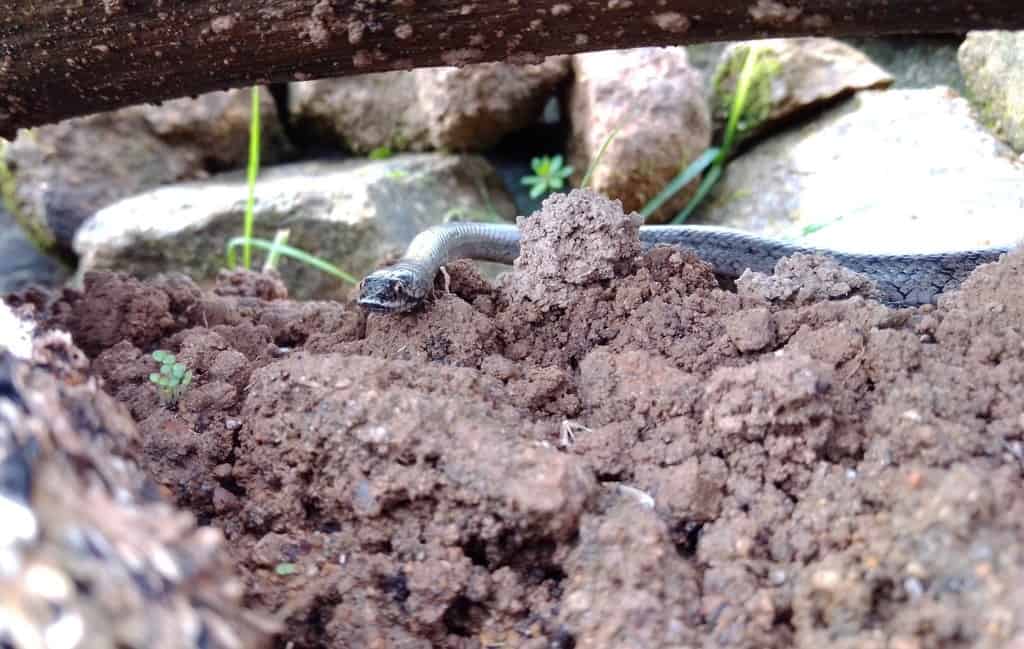
Technically, false smooth snakes aren’t nocturnal. Their eyes have cones which adapt them to daylight vision, and they move around plenty during the day, but only inside their dens. The most they might do during the day is poke their head out and scan their surroundings for a weather report. One time, scientists constructed a terrarium and kept it outdoors to see exactly what this species’ timings were. The average time for their grand exit from the den was 6:00-7:00pm. On rainy days they sometimes left at 3:00pm. Like other nocturnal creatures, they’re the opposite of humans; sensing a decrease in light is what suppresses sleeping hormones like melatonin and forces them to get moving.
The top month for false smooth snakes varies by country. In southeast Spain, they peak from March to June and have a dormant period during summer, but in Portugal, they’re most active from May to July. The last observations of the year before they vanish permanently into their snake hidey holes tends to be the first week of November.
| 5 | Entered Spain only recently |
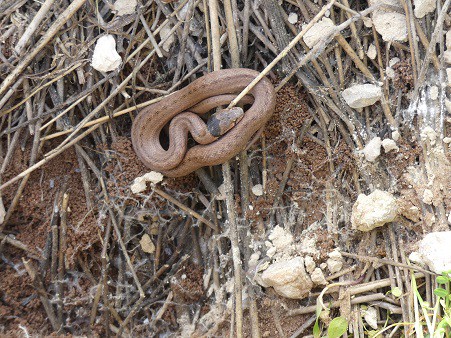
False smooth snakes originated North Africa and have fossils there dating back 2.5 million years. But Spain has almost no fossils – not compared to the ladder snake whose skeletons litter coastal caves, often alongside Neanderthal spears. The most recent are a couple of isolated vertebrae which could be another species anyway.
Scientists believe that false smooth snakes migrated to Spain extremely recently, perhaps in the last ten thousand years, a blip in terms of evolution. Some think that they were introduced to Spain by humans, in Roman boats or the sacks of travelling merchants (similarly to how the ladder snake conquered Ibiza).
If false smooth snakes reached Spain 5.5 million years ago, when North Africa and southern Europe were last in contact, then the predicted rate of genetic divergence would be 11-17%. However, a 2004 study found a tiny divergence between the two populations of just 0.01%. Moroccan false smooth snakes look almost identical to Spanish ones as well.
| 6 | Top prey: Iberian worm lizard |
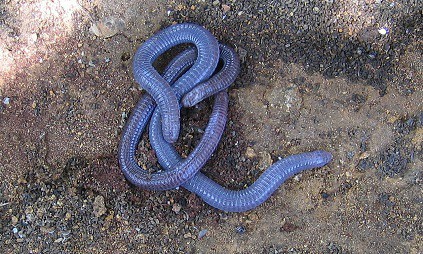
Over millions of years, false smooth snakes have grown into the ecological niche of eating other reptiles. A study in Spain found that 50% of their diet was one species: the Iberian worm lizard. This is an ancient, primitive reptile which superficially looks like a snake, hence having the nickname of “blind snake” in 3 different languages.
It’s ocean blue and measures 15-30cm, and is a burrower which moves around in loose soils, similarly to the false smooth snake. Thanks to this underground lifestyle, its eyes are very small and undeveloped, only able to sense light intensity changes. The only time they reach the surface is to sun themselves on rocks. Iberian worm lizards only live in Spain and Portugal, and their diet consists of insects.
In northern Morocco, meanwhile, the top prey species was the Iberian wall lizard, a common 10cm lizard found all over the western Mediterranean zone (including Spain and Ibiza). The wall lizard also ranks second or third in Spain.
| 7 | They’re starving! |
False smooth snakes are masters of biding their time. Their hunting strategy is ambush, waiting in their intricate burrow networks carved out of soil. They never get out on the prowl, and consistently, only 20% have food in their bellies at any one time, which is far lower than the average snake.
They’re also slow when it comes to killing their prey. False smooth snakes have a mild venom which causes nothing more than a red throbbing in humans. It is capable of killing Iberian worm lizards, plus the Algerian psammodromus and Spanish psammodromus (two other common reptile prey), but from start to finish, the hunting and swallowing process can take 70 minutes. The Malaysian blue coral snake can get the job done in 5 minutes.
False smooth snakes never swallow their prey until dead, and there’s a very logical explanation: they coexist with soil miners, and any live prey swallowed might have the ability to mine downward and straight out of the snake’s belly. They also swallow 95% of their prey by the head.
| 8 | Birds dislike their taste |
A happy upside to being a shy soil citizen is that false smooth snakes have no particularly notorious predator. The bird-obsessed short toed eagle ignores them completely, for reasons only they know. Their top bird predator is the red kite, but even then, they only make up 0.6% of its diet.
In keeping with their reclusive nature, false smooth snakes lack a reputation for savagery when cornered. Their first instinct is to cower and tuck their head into their coils in fright, an instinct some snakes use to protect their brains. The false smooth snake is a slow moving species, so hiding is their only choice if caught in the open.
However, they do bite repeatedly if picked up, a painful pinprick which has never caused a human death on record (the only possibility could be a freak allergic reaction long ago). Tame as they are, this does make them more dangerous than the grass snake, which almost never bites and defaults to playing dead when picked up.
| 9 | The Macropotodon snake clan |
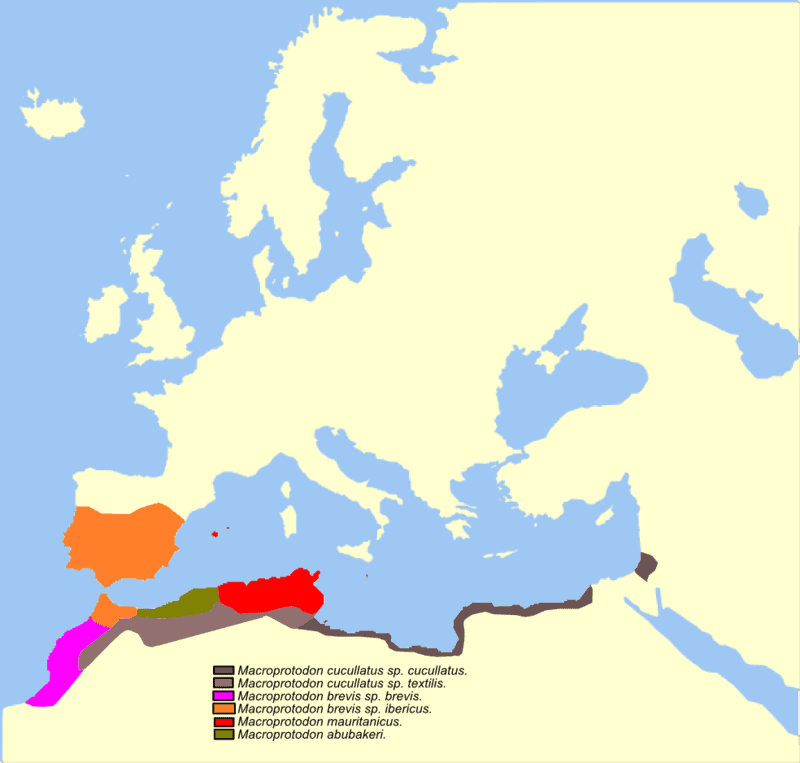
There are actually 4 different false smooth snake species, 3 of which are barely researched. The one we’ve been discussing is the western smooth snake (Macroprotodon brevis), mainly because it’s overwhelmingly the best researched, living in westernised Spain and Portugal. This is the only version to live in Europe, but the western false smooth snake also inhabits the eastern half of Morocco and Algeria.
The second is the eastern false smooth snake, or Macroprotodon cucullatus. This lives from Libya eastwards, including Egypt and southern Israel. It’s the most distinct version as the vast majority have a completely black head, with a horseshoe-shaped pale marking below the eye.
So far, so easy to understand then, but the remaining two species have kingdoms in North Africa which often overlap with the western version. These are Aboukeur’s false smooth snake and M. mauritanicus (which doesn’t get an actual name), which are mostly separated by number of scales, maximillary teeth, and other stuff inaccessible to a snake-interested layman. Adding to the complication, the Western smooth snake has an extra subpsecies: Macroprotodon brevis brevis, which overlaps with those two. The Spanish version is called Macroprotodon brevis ibericus. The map above is only a rough guide to their empires.
| 10 | Reaches 3000m in North Africa |
As urbanisation swept over Spain, some snakes such as the Montpellier snake coped perfectly well. The false smooth snake, on the other hand, is now classified as “near threatened” as they’re much poorer at adapting to manmade structures (though not terrible). Their moist forest edges and damp meadows have slowly retreated over the last century, although there’s now hope given the scores of empty villages in the centre of Spain (caused by a declining population).
The false smooth snake is much more common in Portugal and southwest Spain than south-east Spain. Their range peters out around the centre of Spain; there are none straying into France or Italy. In Spain they have an altitude maximum of 1500 metres, but in the warmer High Atlas of Morocco, they’ve been spotted at 3000 metres.
Eggs are few in this species, with the female average being 4.2. In captivity, 6 eggs is considered to be a strong haul, and they only reproduce every two years. It’s another way in which the false smooth snake is slow and patient. Their favourite spots for laying are very ordinary: beneath rocks, rubble, or between layers of decomposing vegetables.
